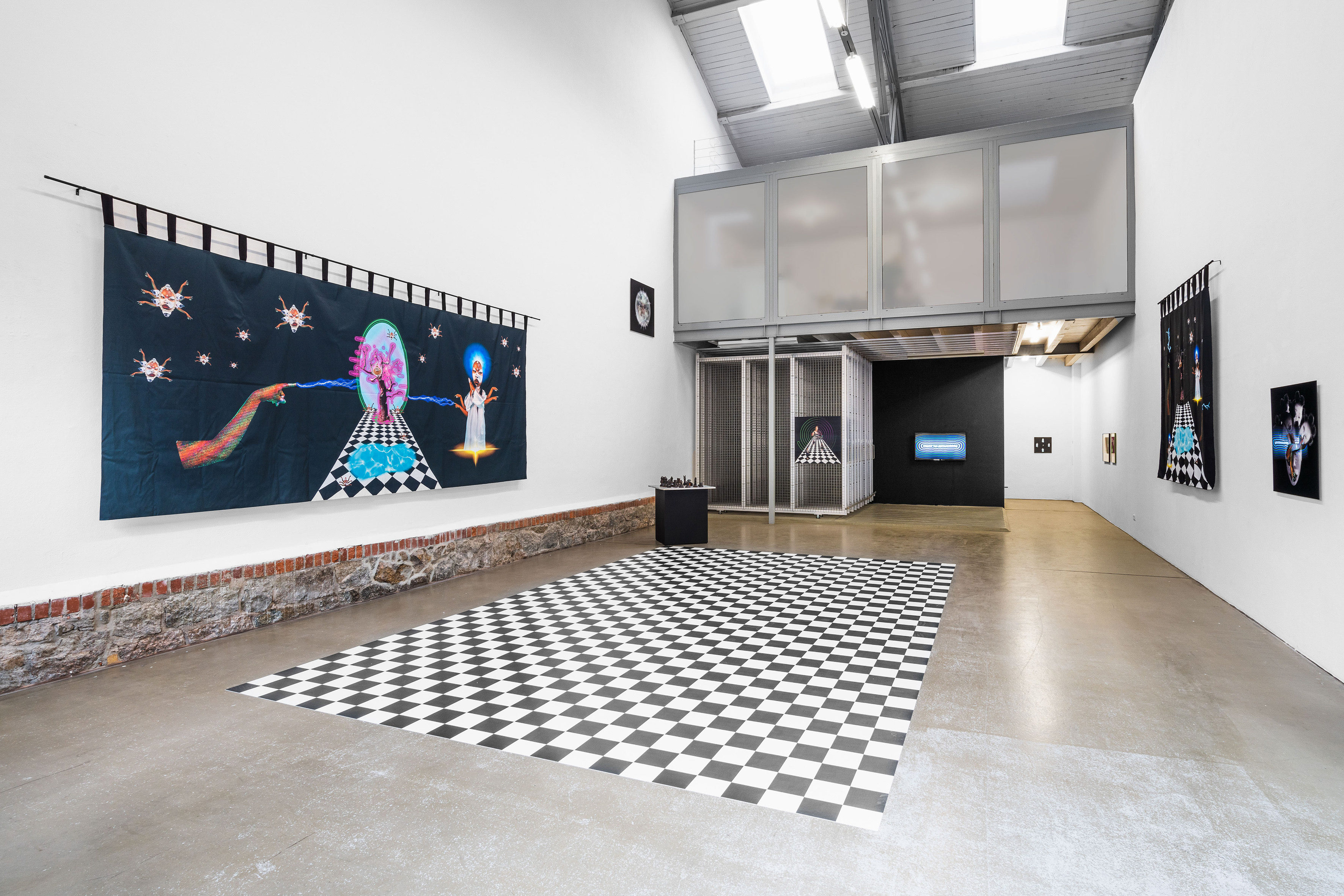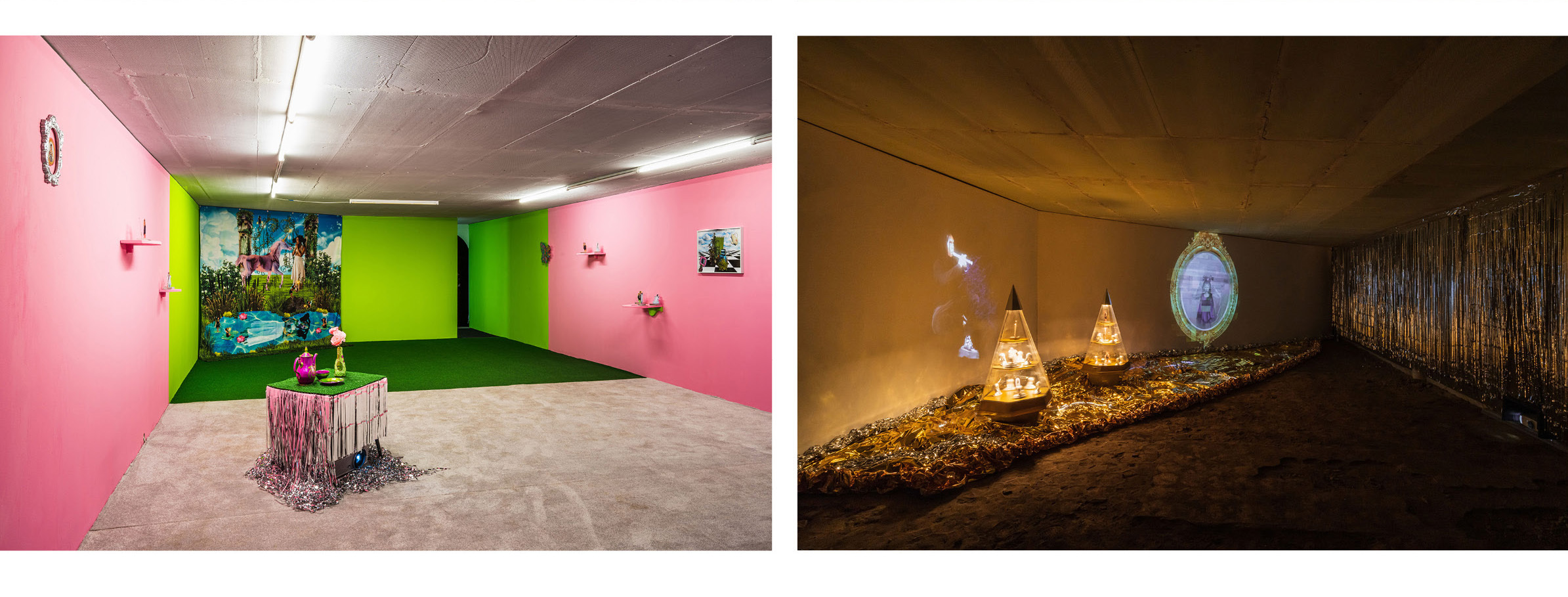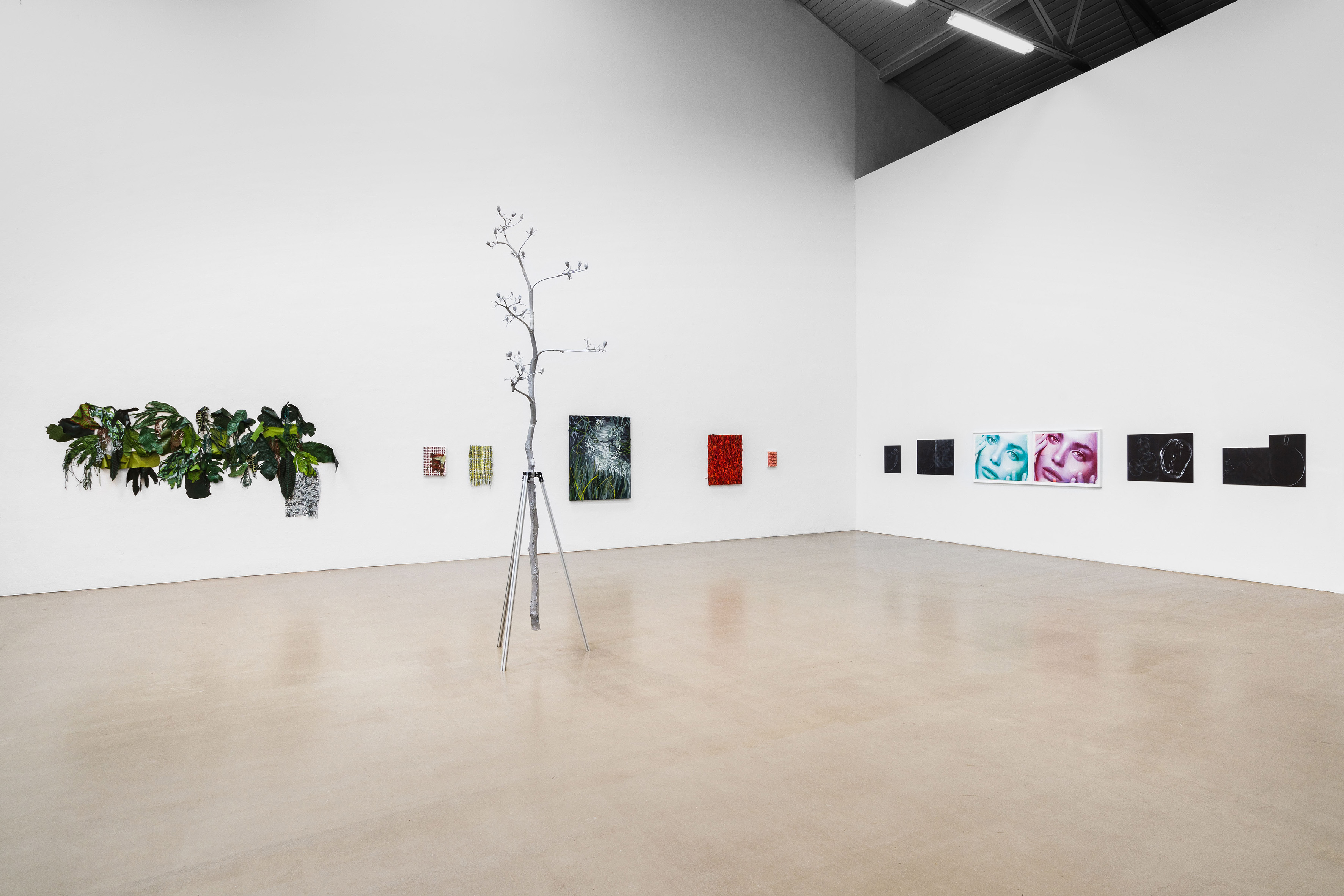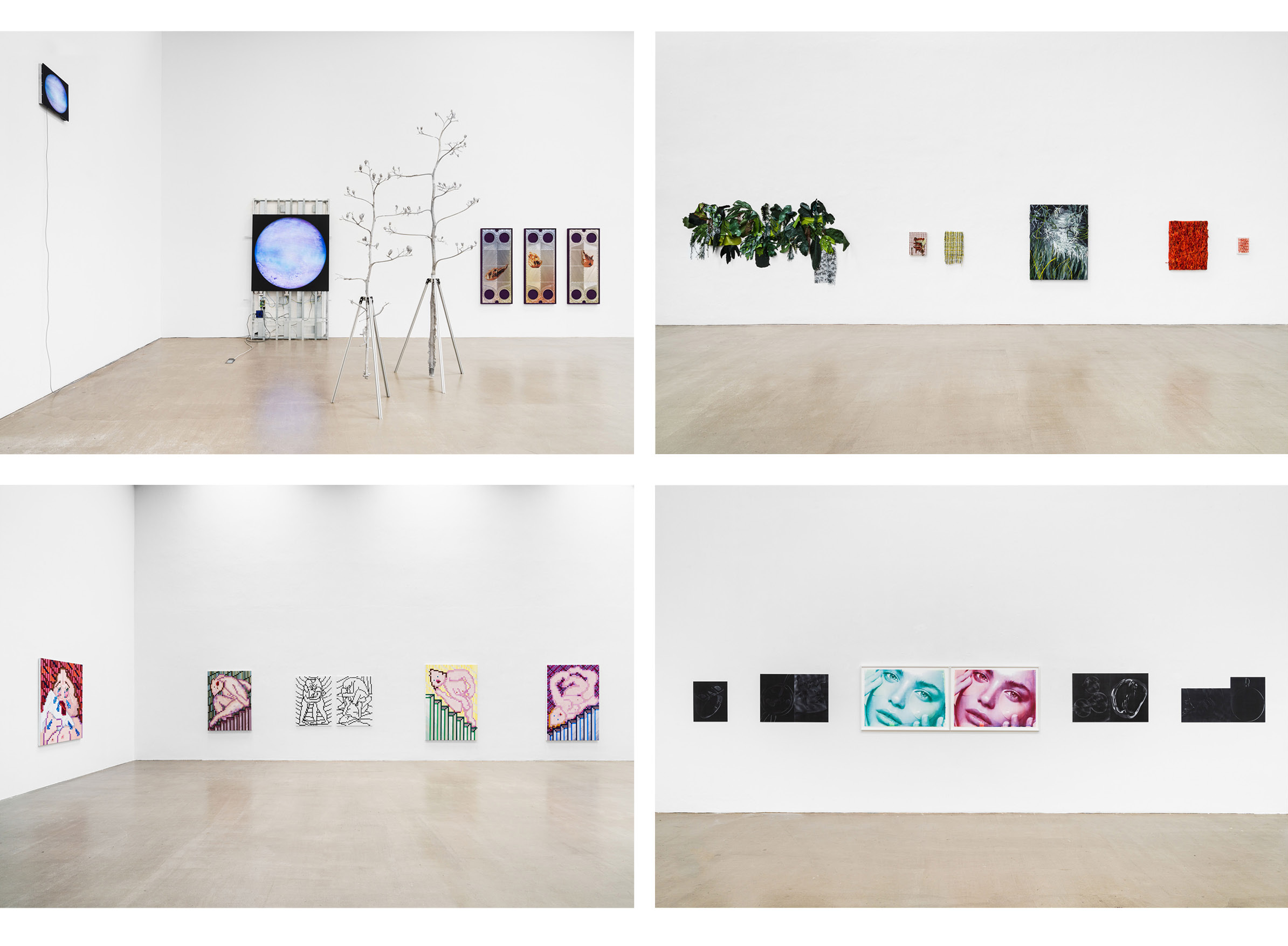We are pleased to open two exhibitions on June 8 from 5 – 9pm at Galerie EIGEN + ART in Leipzig!
Natalie Paneng with new works in her first solo exhibition worldwide with the title Maze.
And the group exhibition Mixed Media with four artistic positions from Leipzig, Berlin and Cape Town:
Malte Bartsch, Gabrielle Kruger, Maria Schumacher and Hanna Stiegeler.
1. Text for the show Maze by Natalie Paneng
2. Text for the group show Mixed Media - please scroll down.

Natalie Paneng
Maze
June 8 - August 19, 2023
About Natalie Paneng
With her practice, multidisciplinary artist and world builder Natalie Paneng remakes herself in digital spheres — detaching her body from its restraints and scrambling it up in ecstasy — for her, play is an always-present friend and the internet is her limitless playground.
I enjoy kind of limitlessness that the internet offers as a platform. A space where I don’t have to follow the same rules and etiquette as IRL. It allows me to explore and contribute freely. I can take up some space and decide how I want to be present.
Natalie taught herself photography and videography, focusing mostly on self-portraiture — which she continues to develop through ongoing process and practice — using these forms to represent herself through different personas and characters.
[S]he has detached [her] body from those restraints. [S]he is teasing time and space. [Her] body is a needle...Now [s]he scrambles history with [her] bod, makes it all a game for the body to enjoy. (Binyavanga Wainaina, 2011)
For Natalie:
Play is political because it is a rejection of the rules and it is a mode of exploration…I’m creating new a territory for myself…It's important to me to normalise what I am, so that I feel comfortable navigating the world authentically but also because I would like others to feel the same freedom — which I hope will just become a cycle, the more we feel seen the more we make others feel seen.
Written by Lindiwe Mngxitama for We Are Culture (2022).
Abstract
The following is an exhibition text in the form of a short story, unpacking the ideas and provocations winking and glitching at the nexus of artist and world-builder Natalie Paneng’s Maze solo exhibition showing at Galerie EIGEN + ART from 8 June 2023.
A Song of Waywardness and (Un)Making
Samā did not quite know where her story began. What she knew was what she had been told – by The Authority, The Professors and The Politicians – about the histories that concerned her making, the stories that told about the tributaries which had ebbed and flowed into the moment of her birthing. However, she also knew, could not ignore or wring out that the facts she had been taught, not only about who she was but also about who she could be, did not feel quite right. That deep within them lay an unshakable presence of absence.
She had always felt expansive and infinite, and she had always thought of herself as having more in common with the Cosmos and the Oceans than with people – ebbing, fluvial, dripping, coursing, traversing time and space, pooling as both matter and meaning. A destined feeling some would say, initiated by her mother naming her “Samā”. An ancient name and word with layered meaning and origin. Samā rose to a pool of sunlight warming up her face, lifting herself from her bed – she gathered and called herself back from her field of dreams – yawning and stretching into her body, and out of the entanglement of her bed sheets. Greeting her shadow, she hummed the tune of the first song she had ever heard, the one which kissed her once tiny ears introducing the world to her and her to the world. It had been sung softly to her by her mother, as she cradled a cooing Samā in her tired hands after a long night of labour.
It was a song that had visited Samā in her dreams for as long as she had been alive. It went where she went, calling her by her name and asking her questions in melody and music, about skin and bodies, abundance and lack, being and abstraction, about being a glitching body and about death and resurrection. It never came alone, this song and music of (un)making, instead it always brought with it three figures – Moipone, Lefifi and Bobedi – who she now thought of as embodied extensions of the labyrinths of existence and contradictions flowing within her.
Moipone’s journey was one of making the path clear, of illuminating the way through soft kind codes using rhythm and sound, whereas Lefifi played and lived in the space of voids searching for messages and signs on shadows. Between Moipone’s light and Lefifi’s shadow was where Bobedi made her home, embracing her duality and hopping, skipping and glitching in the expanse of yes-and-but-also. She reminded Samā of the last thing her mother had said to her, that she was a part of everything. That all of the atoms that were her, were also part of the air and the wind and the trees and the earth…That she lives in the birds and flowers and dragonflies and pine trees and in clouds and in those little specks of light you see floating in sunbeams.
Samā sang her mother’s last words to the melody of her song of waywardness and (un)making – conjuring through her own breath her mother’s. Waywardness as in the practice of possibility, and waywardness as in an unrepenting, ongoing symphony of the improvisation and the exploration of what might be. Coating her skin in a mixture of shea butter and nourishing oils, and tracing the fleshed borders of her being, a smile spread itself across her face. A smile birthed from the belly of the half formed thoughts and the alleyways of interrogation keeping her company that morning, along with the lingering memory of her dream from the previous night. The dream was of her in a maze skipping along in search of Moipone, Lefifi and Bobedi. “Perhaps there is more to a maze than meets the eye?” She thought to herself. “Can a person also be a maze…and if so, what would that mean?” she carried on.
Samā thought about The Authority, The Professors and The Politicians, about everything that they had told her about who she was and who she could be, and why it never resonated with the song that followed her wherever she went. The Authority, The Professors and The Politicians had tried to make her into a binary body, when she was actually a maze body; a body in glitching (r)evolution. Breaking the back of Time and the suffocating Logic of Either/Or with each layer of new skin she grew.
*italicised parts in the text quote works by other authors
Bibliography
Hartman, S., Wayward Lives, Beautiful Experiments: Intimate Histories of Riotous Black Girls,
Troublesome Women and Queer Radicals, W. W. Norton & Company, 2019.
Neimanis, A. Hydrofeminism: Or, On Becoming a Body of Water. In Undutiful Daughters, New
Directions in Feminist Thought and Practice. Ed. Gunkel, H. Nigianni, C & Söderbäck, F. New York:
Palgrave Macmillan, 2012.
Russel, L. Glitch Feminism: A Manifesto, Verso, 2020.

____________________________________________________________________________________

Malte Bartsch, Gabrielle Kruger,
Maria Schumacher, Hanna Stiegeler
Mixed Media
June 8 - August 19, 2023
“Thanks for your visit"
Heidi Stecker
This exhibition presents a small group, or rather presents four very individual standpoints and perspectives that use media to respond to our present.
Malte Bartsch, born in 1984 in Braunschweig, lives and works in Berlin. His emblematic sculptures, installations, and objects often allude to physical laws, but various displacements shift the structure of the familiar order. Life and technology collide. Everyday events, experiences, and observations are transported into grotesquery by tearing materials and functions from their original context, restructuring them, or even reversing them. Some 170 moons keep our planetary system in balance. If a single one changed its orbit, would our living conditions on earth begin to teeter? In “Mond (chaotisch)” [“Moon (chaotic)”], one such satellite slowly moves on an LED surface (150 cm × 150 cm). Over time, we notice a change: in video animation, a new moon appears in our solar system. Irregularly, interference signals appear; photo resistances bring a video signal out of balance. We view a seemingly stable system, but chaos can erupt at any time.
Gabrielle Kruger, born in 1993, lives and works in Cape Town and currently also in Berlin.
The artist transposes traditional European landscape painting into the third dimension: instead of painting overwhelming or comforting compositions with mountains, a waterfall, and trees, she zooms down onto details, does without accessory figures, and interprets the synthetic surfaces as real spatiality. Kruger constructs landscapes and at the same time uncovers their layers. She attaches strands and threads of acrylic paint to the substrate, as a way of grounding them. The drying paints contrast with what lies below, and they grow into reliefs. The assemblies simulate nature: “nature” is first created by human activity and is submitted to human productive needs and logics of utility. Nature and painting become an object, sculpture, and performance.
Maria Schumacher, born in 1983 in Bucharest, lives and works in Leipzig. Her pictures are concentrated and simultaneously fleeting, hinting reflections of basic human feelings: they mirror the desire for closeness, affection, corporeality, but also loneliness, fear, and endangerment. In the abstraction, it is not always recognizable whether violence is involved. The materials and techniques can seem to be a mixture of knotting craft and mosaic. A textile component is present in all her work groups. The series “Outcome of the Pattern” (2022, egg tempera on canvas, 120/125 × 90 cm), for example, shows couples’ heartfelt embraces that intensify into initially enigmatic, but then recognizably sexual acts. The figures are reduced to contours. They are reminiscent, on the one hand, of early digital aesthetics and the first experiments from the beginnings of computer-generated art and animation, and on the other hand, of embroideries on wool with necessarily simplified gestures.
The photographer and multimedia artist Hanna Stiegeler lives and works in Berlin. She collects banal visual and photographic material that circulates everywhere on the Internet and on packaging, in magazines, and in books. Stiegeler separates the images from their contexts; they thereby reveal their complete abstruseness and thus are perhaps depictions of our world’s absurdity.
Round forms seem to trace a continuous collection of connecting threads through the photos: this could be a petri dish with cultures and a pipette – or is it a cell being artificially fertilized? Combined with a (child’s) hand towel with a Bambi deer overprint, we can also discover soap bubbles, floral sweeps, excerpts of the feet of a dancer or gymnast with a ball. Stiegeler composes and assembles the photos to diptychs or triptychs, thereby alluding to superbly sublime figurations of (religious) art.
